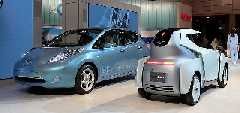Prospective Electric Vehicle Owners Analyze Break-Even Point on Fuel Costs
Cameron Atwood writes:
I recall seeing figures indicating the $45k Volt pays off the difference in savings on gas over electric cost over its ICE (internal combustion engine) brethren in six years. That’s not especially dismal.
It depends on how far you drive, and, in the case of a plug-in hybrid like the Volt, how you drive, i.e., how seldom you exceed the battery-only range (about 35 miles) and start to use gasoline. The analysis is easier with a battery electric like the LEAF. Let’s say:
• You pay $30K for the LEAF after rebates
• This is $10K more than you would have paid for an equivalent ICE car
• The ICE car would have gotten 30 MPG
• Gas is $4 per gallon
• Electricity is the equivalent of $0.60
You’d break even at 85,000 miles. So you’re right, it’s not too dismal.
And I love the dialog my friend Paul Scott, who put his EV consulting career on hold to go sell the LEAF at Nissan’s downtown Los Angeles showroom, has with his prospects who are sitting on the fence on this issue. It begins with Paul’s asking, “Now, let’s put an extra price on gasoline. In addition to the $4 you’re paying at the pump, how much extra would you be willing to pay for fuel, which, when taken from renewable sources, doesn’t cause lung disease, global climate change, and dead soldiers?
This, of course, can go one of two ways. Fortunately, most prospects come up with a realistic figure, making the case for the LEAF very attractive. But occasionally a prospect says “zero.” Here’s where it gets ugly. Paul says, “Oh. I’m sorry to hear that. You’re not a very good person, are you?”
As I told Paul when I heard this, “Ouch! I’m glad I’m not in the room when this happens.”


Modern electric cars are a new technology and will first be bought by prosperous people whose primary concern is not economics. However, by buying them, they will be helping to advance the technology so that electric cars may become more practical in the future causing people of more modest means to buy them.
We can’t be certain of very much, but I believe that electric cars have considerable potential.
Craig,
Gasoline has ~35 kWh of stored energy. There’s no one on Earth that is going to pay $0.60/gge in electricity.
If an EV gets 3 miles/kWh (not likely) and a car gets 30 mpg, then the equivalent energy to drive 30 miles would be 10 kWh for every 1 gallon of gasoline.
If you use a slow charger, there’s only ~10% charging losses, but a fast charger has 25% charging losses.
So you have to purchase between 11 and 12.5 kWh for every gallon of gasoline that an ICE vehicle would use.
After 85,000 miles, the ICE driver would spend ~$11,333 in gasoline, while the EV driver – assuming an incredible 3 miles/kWh and no losses from the vehicle remaining idle – would purchase $3,116 worth of electricity.
Does that then mean that a price difference of $8,216 would see a break-even point in 7 years if driven 12,000 miles/year?
No.
There’s the cost of money to consider, and the opportunity cost of the payments to consider.
A 30,000 vehicle at a 5% annual rate for 72 months would cost $483.15/month, while the same for a $20,000 vehicle would cost 322.10/month. That’s a difference of $161.05/month. The optimistic difference in fuel bills (assuming 1000 miles/month, slow charging, $0.11/kwh, and $4/gallon) is $92.99/month.
So the EV driver is losing $68.06/month to the ICE driver.
If you assume a reasonable rate of return from a diverse investment portfolio is 6%/year, and compound the $68.06/month with that ROI assumption, then by the end of the 6 year car loan the ICE buyer has a compounded advantage $5956.51 against the EV driver. At 6% ROI, the ICE driver is making back $30/month on his/her compounded gain.
At THAT point, then the ICE starts seeing a monthly disadvantage of $92.99/month… but with the interest accruing it will take 77 additional months before the vehicles break even.
Of course, no-one expects the battery pack to last 12 years and 5 months… so that’s not going to work.
When you use real numbers – like the $33,500 base price for the Leaf vs the $12,000 base price for a comparable Versa… it looks a lot worse.
Craig,
Sorry about the tone of my last two comments. I’ve been working some crazy hours recently.
🙂
Think nothing of it!
Good point about the cost of money.
A couple of other points:
In terms of Whs/mile, LEAF owners (24 kWh battery) get 100 miles range in the real world, and (obviously) don’t fully discharge their batteries.
I would think the TCO (total cost of ownership) analysis would have to include the cost and hassle of maintenance. No tune-ups, smog-checks, oil changes, dead batteries, greatly reduced parts and labor over a vehicle’s lifetime, greater reliability.
Of course, EV owners DO need to be concerned about the total battery life.
EVs should be more reliable than vehicles with IC engines. They are much more simpler mechanically. Unfortunately, the cost of money is often neglected in making cost comparisons. Also, to be fair, the cost comparisons should be made without government incentives.
Even now, I think that there is a place for EVs. Some people have jobs that require them to do a lot of driving in city traffic and for them, EVs could well be economically justified even now.